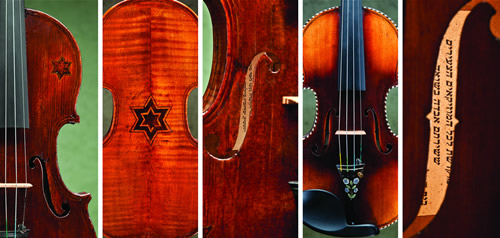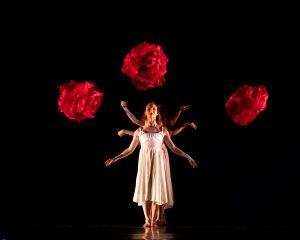Largely the brainchild of Israeli violinmaker Amnon Weinstein, who sought out instruments played by victims and survivors of the Holocaust, restoring each one to playing condition regardless of their artistic pedigree, Violins of Hope is a tribute to the primacy of music amid brutality, to the attachment between the Jewish people and the violin, and to the impulse of never forget. While presenting the first exhibition of the Violins of Hope in the Western Hemisphere, UNC Charlotte organized two additional exhibitions on campus and at their new Center City Building. They also presented three lectures and discussions, including one on violinmaking by Weinstein. The most adventurous part of the Violins of Hope celebration was arguably the theatre event on campus premiering a new play, Project/Hope, written by playwright Joe Salvatore in collaboration with 12 students in his fall semester class.
But the events that drew the most attention – and the most emotional response – were the five concerts in the city where artists of international stature, such as Shlomo Mintz and Hagai Shaham, played on the violins that Weinstein had restored, bringing them fully back to life. UNCC seemed to get everything right at the two exhibitions I witnessed at the City Center Building and at their opening concert, “Restoring Hope,” at Knight Theater. Beyond the programming, the curating, and the rich contextualization, UNCC got the timing right, for the Violins of Hope celebration overlapped Yom HaShoah, the day set aside annually for Jews to commemorate the lives lost in the Holocaust. So emotionally, Violins of Hope peaked with the Yom HaShoah concert at Temple Israel, combining soul-stirring music with solemn ceremony.
There was a slight shift in emphasis, appropriate for the occasion. Instead of Weinstein, who hosted “Restoring Hope,” Rabbi Murray Ezring hosted the Yom HaShoah event, and instead of seeing the 18 Violins of Hope spotlighted onstage, we saw 20 memorial candles set on a table in front of the sanctuary. For those of us who were fortunate enough to pick up the supplementary inserts for the Violins of Hope program booklet, there was little mystery to the candles or their number. After a reading from Elie Wiesel’s Night, perhaps the most famous memoir by a Holocaust survivor, Rabbi Ezring called upon the 20 Holocaust survivors and liberators attending the event to light the candles. It was a solemn, moving procession – for all of these people were elderly, many of them accompanied to, or assisted at, the candle-lighting ceremony.
Opening the concert, Mintz and pianist Sander Sittig seemed to resume where they had left off on Sunday evening, when they had concluded the “Restoring Hope” concert with a stirring performance of Ernest Bloch’s Violin Sonata No. 1. Now they played “Nigun” (or “Melody”) from Bloch’s Baal Shem: Three Pictures of Hassidic Life. If the piano had been slightly subdued at Knight Theatre, it sounded preternaturally loud up in the balcony where I sat at Temple Israel. Yet Mintz’s violin – his borrowed violin – sounded wonderfully natural, and while “Nigun” started off with turbulence reminiscent of the Sonata, it soon drifted into a tranquil repose that was distinctively Hassidic in its flavor, defining the unrest that had preceded it. The subsequent turbulence was now flavored with sanctity and yearning, melting into a final ethereal episode that poignantly faded out.
Turkish violinist Cihat Askin played on two consecutive selections, beginning with his own arrangement of Yiddish Fantasy, accompanied by Sittig. The lachrymose minor-key opening slowly gained momentum and sprightliness, and Askin’s playing actually improved as he sailed through the more challenging double-bowed passages. Sittig played a transitional solo magnificently before Askin returned in a more traditional vein. This led to a merrier exchange between Sittig and Askin with a klezmer-like jump in its step. An even swifter, merrier exchange ensued, capped by a frenetic cadenza by Askin. Sittig took a brief break as Weinstein came onstage to read a poem by Avram Gunter translated by Assaela Weinstein, Amnon’s wife. The program proceeded no less adventurously when Sittig returned with Shaham to play Joseph Achron’s Hebrew Melody. The Hebraic nuances of the simple, lyrical opening carried over into an agitated, virtuosic tirade that followed, played by Shaham with seamless poise and eloquence. High soft trills in the ensuing soft passage were hardly less challenging as the piece ascended to its quietly sanctified conclusion.
The tone grew darker as we heard more of Bloch’s ethnically charged music, this time his “Rhapsody” from Suite Hébraïque, played on Richard Crabtree’s viola with Sittig’s accompaniment. Sweet mournfulness gave way to a nobler section marked by agitated struggling before we circled back to the solemnity of the opening trope, a little more brooding as it faded out. The piece was a perfect preamble to the selection from Weisel and the candle-lighting ceremony. But what could possibly follow that grim spectacle? Why, nothing less than Beethoven’s “Kreutzer” Sonata, played by Mintz and Sittig. Although they only played the first of the Kreutzer’s three movements, in that portion Mintz and Sittig were the equals of the best live “Kreutzer” that I’ve heard, when violinist Daniel Hope and pianist Sebastian Knauer performed the complete Sonata No. 9 at the Savannah Music Festival last year. Hope/Knauer were more precise, more electrifying in their dynamic contrasts, but Mintz and Sittig were wilder, more emotional in their playing. By this time, I’d gotten accustomed to the forwardness of the piano, and Sittig continued to excel when called upon to take the lead. With Mintz’s intensity and bravura, Sittig’s marvelous interludes became respites in the passionate overarching argument. The performance was an inspiring reminder that Beethoven’s freedom-loving spirit was antithetical to the brutes’ who took over his fatherland. What also moved me was the realization that hundreds of people crowding the sanctuary to commemorate the six million souls who perished in the Holocaust were getting a first taste of the wonders to be found, in glorious profusion, in music by Beethoven outside his familiar orchestral music. The music itself, in its noble fury, also presented an additional way to react to the monumental tragedy – a never again uttered almost like a battle cry. Whatever the components of Mintz’s performance may have been that touched his audience, they rose in a thunderous standing ovation.
Again, there was a perfect sequel, a Yiddish poem by Abe Luski that commemorated Jews who died in the Holocaust, interspersed with the traditional Aramaic of the Mourner’s Kaddish. Cantor Elias Roochvarg then chanted the “El Malei Rachamim” funeral prayer in the version appropriate to the Yom HaShoah before cellist Hillel Zori came up to the stage with Sittig to play two final classical pieces. Both of these warm pieces had overtly sacramental themes, Joachim Stuchevsky’s Kaddish and Max Bruch’s Kol Nidre. Zori’s résumé includes numerous competition prizes and stints with the Israel Philharmonic and the Israel Piano Trio, but I had never heard of him. After hearing his luscious tone poured into a mixture of cantorial melodies, I’d love to hear more.












